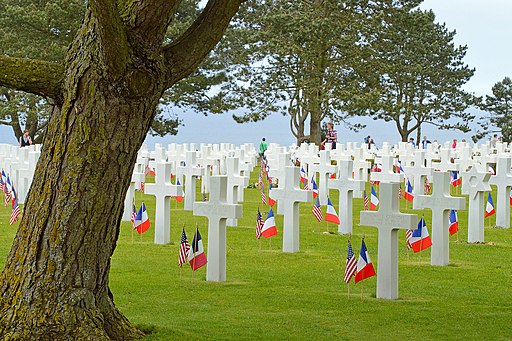| Landing Beach Normandy |
Omaha Beach : On June 6, 1944, 5 divisions convoyed in nearly 4,300 barges and protected by nearly 500 warships landed at daybreak in Normandy on the 5 beaches called Utah, Omaha, Gold, Juno and Sword. Despite the element of surprise, the German response inflicted heavy losses on the Allies during the early hours of the morning. The conquest of Omaha Beach was difficult.

Into the Jaws of Death: Troops from the U.S. 1st Infantry Division landing on Omaha June 6, 1944, as photographed by Robert F. Sargent
Sword Beach with the British and the French
France is represented in this land operation by the legendary 1st Marine Rifle Battalion (1er BFM). Lieutenant Kieffer (better known as “Kieffer Commando”) landed at Sword with the British. Composed of men who joined General de Gaulle in 1940, the 1st BFM distinguished itself by a heroic feat of arms. Indeed, they seized the Ouistreham casino, fiercely defended by the Germans.
Throughout the day of 6 June, the Allies set up bridgeheads to continuously bring in reinforcements and equipment. The Germans reacted with pugnacity once they had regained their senses. From then on, land battles were fierce. Towns were the systematic targets of bombing by the Allied air force (in particular Saint-Lo, Falaise and Caen).
Omaha Beach struggle
By nightfall, the situation was stabilized but uncertain. While German reinforcements converged from all over the scene of the fighting, the Allies, took advantage of the absence of a German naval and air response. They managed to land 156,000 men and nearly 20,000 vehicles of all types. Allied casualties amounted to nearly 10,500 men, a third of whom were killed in combat.
“Omaha” refers to an 8-kilometer (5 mi) section of the coast of Normandy, France, facing the English Channel, from east of Sainte-Honorine-des-Pertes to west of Vierville-sur-Mer on the right bank of the Douve river estuary. The primary objective at Omaha was to secure a beachhead 8 kilometers (5 miles) deep, between Port-en-Bessin and the Vire river, linking with the British landings at Gold to the east, and reaching the area of Isigny to the west to link up with VII Corps landing at Utah.
Overall, the landing was successful. The German coastal defenses were destroyed and nowhere were the attackers thrown back into the sea. However, the results were mixed, as not all objectives had been achieved. In addition, the position remained very indecisive at Omaha Beach. This success of the “longest day” actually begins the Battle of Normandy, the second stage of the liberation of France.

Peter K Burian, CC BY-SA 4.0
American Cemetery by Omaha Beach
The cemetery of Colleville-sur-Mer is an American military cemetery located just above one of the landing beaches named Omaha Beach. It is in the Calvados on one of the sites of the Allied landings of June 6, 1944. Officially inaugurated on July 18, 1956 with its memorial, this cemetery honors American soldiers and civilians who died during the Battle of Normandy during the Second World War. It also honors those of the Army Air Force shot down in 1942. It is one of 25 burial sites United States permanent staff on foreign soil. The cemetery replaced a first temporary one, known as Saint-Laurent, established nearby on June 8, 1944. The first American military cemetery of the Second World War, it was designed by the architects Harbeson, Hough, Livingston & Larson (firm architect H2L2). The landscape architect is Markley Stevenson.
West end of the Omaha Beach cemetery
Two granite statues guard a small semi-circular space decorated with benches conducive to meditation and remembrance. The first, Columbia, carries an eagle and represents the United States while the other, Marianne, carries a rooster and represents France. These two allegories, each holding an olive branch, symbolize Franco-American friendship.
Reception Building
A semi-circular Memorial, with a bronze statue is depicting “the Spirit of American Youth rising from the waves.” As an extension of the basin where the Memorial is reflected, the central avenue leads to the 10 squares of tombs. 9,387 soldiers, including 4 women and 307 unknown soldiers. 14,000 remains, first buried in Normandy, were repatriated to the United States, at the request of their loved ones.
Right of the entrance
A capsule which will not be opened until June 6, 2044 contains press articles published at the time. It is a message from Eisenhower addressed to future generations. Dwight David Eisenhower, nicknamed Ike, was an American military officer and statesman who served as the 34th president of the United States from 1953 to 1961. During World War II, he was Supreme Commander of the Allied Expeditionary Force in Europe and achieved the five-star rank as General of the Army.
East of the Omaha Beach memorial
The arc formed by the garden collects the mortal remains of 1,557 drowned or unidentifiable American soldiers. A chapel stands in the middle of the tombs, and hosts a colorful mosaic symbolizing America blessing its children as they leave to fight for Freedom. A flight of steps leads to the sea, from where the visitor enjoys a wide panorama of Omaha Beach, illustrated by orientation tables.
Rest in front of Omaha Beach
3 holders of the Medal of Honor who died in Normandy rest in Colleville. It includes General Theodore Roosevelt Junior (1887-July 12, 1944, eldest son of President of the United States Theodore Roosevelt and distant cousin of President Franklin Roosevelt). Two of the Niland brothers, whose story inspired Steven Spielberg to write the screenplay for the film “Saving Private Ryan”, are also buried here.
You may not participate to the June 6, 1944 – Normandy Landings anniversary but you can have 1 day private Normandy Tour with a private guide and a private driver.
Emy,

